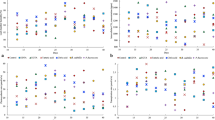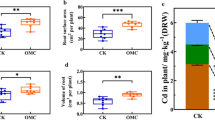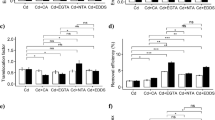Abstract
Purpose
The aim of this study was to compare organic and inorganic amendments namely citric acid, ammonium nitrate, compost, and titanium dioxide nanoparticles (TiO2 NPs) with ethylenediaminetetraacetic acid (EDTA) in enhancing the bioavailability of cadmium (Cd) in assisted phytoextraction.
Materials and methods
Uncontaminated soil was spiked with different levels of Cd (25–150 mg kg−1) by using CdSO4 salt. Different levels of five amendments used were as follows: EDTA (0–5 mmol kg−1), citric acid (0–10 mmol kg−1), ammonium nitrate (0–10 mmol kg−1), TiO2 NPs (0–100 mg kg−1), and compost (0–10%). Pelargonium hortorum plants were grown on amended soils for a period of 6 months and different parameter were considered to evaluate bioavailability of Cd upon application of amendments.
Results and discussion
The bioavailability of Cd in soil was increased by 1.2-, 0.8-, 0.4-, and 0.2-fold in EDTA, citric acid, ammonium nitrate, and TiO2 NPs, respectively. However, Cd bioavailability was decreased by 0.5-fold in compost-amended soils. The efficiency of amendments for mobilizing Cd followed the order: EDTA > citric acid > ammonium nitrate > TiO2 NPs > compost. The maximum accumulations of Cd in root (350 mg Cd kg−1) and shoot (943 mg Cd kg−1) were observed upon EDTA application and minimum concentrations in root (125 mg Cd kg−1) and shoot (104 mg Cd kg−1) were observed in compost-amended soils. The maximum (2.7 g) and minimum (1.5 g) plant biomass was observed upon compost and EDTA application, respectively. The maximum Cd uptake per plant (1.44 mg) and metal extraction ratio (4.4%) were observed in citric acid-amended soils due to better biomass produced.
Conclusions
Among all amendments, citric acid can be recommended as an environmentally friendly and effective substitute to EDTA for assisted phytoextraction of Cd to decontaminate polluted soil as Cd uptake per plant and metal extraction ratio were the highest upon application of citric acid.




Similar content being viewed by others
References
Abbas T, Rizwan M, Ali S, Adrees M, Mahmood A, Rehman MZ, Ibrahim M, Arshad M, Qayyum MF (2018) Biochar application increased the growth and yield and reduced cadmium in drought stressed wheat grown in an aged contaminated soil. Ecotoxicol Environ Saf 148:825–833
Ahmad I, Akhtar MJ, Zahir ZA, Mitter B (2015) Organic amendments: effects on cereals growth and cadmium remediation. Int J Environ Sci Technol 12:2919–2928
Ali SY, Paul M, Chaudhury S (2016) EDTA-enhanced phytoextraction of Cd and Pb in spiked soil with Marigold and associated potential leaching risk. Int J Environ Agric Res 2(5):114–118
Alkorta I, Hernández-Allica J, Becerril JM, Amezaga I, Albizu I, Onaindia M (2004) Chelate-enhanced phytoremediation of soils polluted with heavy metals. Rev Environ Health 3:55–70
Arshad M, Silvestre J, Pinelli E, Kallerhoff J, Kaemmerer M, Tarigo A, Shahid A, Guiresse M, Pradere P, Dumat C (2008) A field study of lead phytoextraction by various scented pelargonium cultivars. Chemosphere 71:2187–2192
Arshad M, Merlina G, Uzu G, Sobanska S, Sarret G, Dumat C, Silvestre J, Pinelli E, Kallerhoff J (2016) Phytoavailability of lead altered by two Pelargonium cultivars grown on contrasting lead-spiked soils. J Soils Sediments 16(2):581–591
Chen YH, Li XD, Shen ZG (2004) Leaching and uptake of heavy metals by ten different species of plant during EDTA-assisted phytoextraction process. Chemosphere 57:187–196
Chen Y, Liu M, Deng Y, Zhong F, Xu B, Hu L, Wang M, Wang G (2017) Comparison of ammonium fertilizers, EDTA, and NTA on enhancing the uptake of cadmium by an energy plant, Napier grass (Pennisetum purpureum Schumach). J Soils Sediments 17:2786–2796
Chhajro MA, Rizwan MS, Guoyong H, Kubra KA, Honging H (2016) Enhanced accumulation of Cd in castor (Ricinus communis L.) by soil applied chelators. Int J Phytorem 18:664–670
Dede G, Ozdemir S (2016) Effect of elemental sulfur on heavy metal uptake by plant growing on municipal sewage sludge. J Environ Manag 166:103–108
Ebrahimi M (2015) Effect of EDTA treatment method on leaching of Pb and Cr by Phragmites australis (Cav.) Trin. Ex Steudel (common reed). Caspian J Environ Sci 13(2):153–166
Epelde L, Allica JH, Becerril JM, Blanco F, Garbius C (2008) Effects of chelates on plants and soil microbial community: comparison of EDTA and EDDA for lead phytoextraction. Sci Total Environ 401:21–28
Freitas EV, Nascimento CW, Silva WM (2014) Citric acid assisted phytoextraction of lead in field: the use of soil amendments. Water Air Soil Pollut 225(1):1796
Gul I, Manzoor M, Hashim N, Kallerhoff J, Arshad M (2018a) Comparison of EDTA, citric acid and TiO2 nanoparticles to support Cd phytoaccumulation in spiked soil. Proceedings of the 2nd International Conference on Recent Trends in Environmental Science and Engineering (RTESE'18) 119. https://doi.org/10.11159/rtese18.119
Gul I, Manzoor M, Rizwan M, Silvestre J, Hina K, Kallerhoff J, Arshad M (2018b) EDTA-assisted phytoextraction of lead and cadmium by Pelargonium cultivars grown on spiked soil. Int J Phytorem. https://doi.org/10.1080/15226514.2018.1474441
Guo JM, Lei M, Yang X, Yang, Wan XM, Chen TB, Zhou XY, Gu SP, Guo GH (2017) Effect of fertilizers on the Cd uptake of two sedum species (Sedum spectabile Boreau and Sedum aizoon L) as potential Cd accumulators. Ecol Eng 106:409–414
Johnson A, Gunawardana B, Singhal N (2010) Amendments for enhancing copper uptake by Brassica juncea and Lolium perenne from solution. Int J Phytorem 11:215–234
Khan A, Khan S, Khan MA, Qamar Z, Waqas M (2015) The uptake and bioaccumulation of heavy metals by food plants, their effects on plants nutrients, and associated health risk: a review. Environ Sci Pollut Res 22(18):13772–13799
Khan MA, Khan S, Khan A, Alam M (2017) Soil contamination with cadmium, consequences and remediation using organic amendments. Sci Total Environ 601–602:1591–1605
Li Y, Tang H, Hu Y, Wang X, Ai X, Tang L, Matthew C, Cavanagh J, Qiu J (2016) Enrofloxacin at environmentally relevant concentrations enhances uptake and toxicity of cadmium in the earthworm Eisenia fetida in farm soils. J Hazard Mater 308:312–320
Mahdieh M, Yazdani M, Mahdieh S (2013) The potential of Pelargonium roseum plant for phytoremediation of heavy metals. Environ Monit Assess 185(9):7877–7881
Manshadi M, Ziarati P, Ahmadi M, Fekri K (2013) Greenhouse study of cadmium and lead phytoextraction by five Pelargonium species. Int J Farm Alli Sci 2(18):665–669
Manzoor M, Gul I, Silvestre J, Kallerhoff J, Arshad M (2018) Screening of indigenous ornamental species from different plant families for Pb accumulation potential exposed to metal gradient in spiked soils. Soil Sediment Contam 27(5):439–453
Mehrizad A, Gharbani P, tabatabii SM (2009) Synthesis of nanosized TiO2 powder by sol gel method in acidic conditions. J Iran Chem Res 2:145–149
Mertens J, Luyssaert S, Verheyen K (2005) Use and abuse of trace metal concentrations in plant tissue for biomonitoring and phytoextraction. Environ Pollut 138:1–4
Muhlbachova G (2011) Soil microbial activities and heavy metal mobility in long-term contaminated soils after addition of EDTA and EDDS. Ecol Eng 37:1064–1071
Neugschwandtner RW, Tlustos P, Komarek M, Szakova J, Jakoubkova L (2012) Chemically enhanced phytoextraction of risk elements from a contaminated agricultural soil using Zea mays and Triticum aestivum: performance and metal mobilization over a three year period. Int J Phytorem 14:754–771
Oldari M, Arthurson V, Pell M, Svensson K, Nehrenheim E, Abubakar J (2011) Land application of organic waste—effects on the soil ecosystem. Appl Energy 88:2210–2218
Pedron F, Rosellini I, Petruzzelli G, Barbafieri M (2014) Chelant comparison for assisted phytoextraction of lead in two contaminated soils. Resource Environ 4(5):209–214
Rizwan M, Ali S, Ali B, Adrees M, Arshad M, Hussain A, Rehman MZ, Waris AA (2019) Zinc and iron oxide nanoparticles improved the plant growth and reduced the oxidative stress and cadmium concentration in wheat. Chemosphere 214:269–277
Sarkar D, Andra SS, Sumathi KM, Saminthan DR (2008) Chelant aided enhancement of lead mobilization in residential soils. Environ Pollut 156(3):1139–1148
Shahid M, Austruy A, Echevarria G, Arshad M, Sanaullah M, Aslam M, Nadeem M, Nasim W, Dumat C (2014) EDTA-enhanced phytoremediation of heavy metals: a review. Soil Sediment Contam 23(11):389–416
Shazia A, Shazia I, Mahmood U (2014) Effects of chelating agents on heavy metal extraction from contaminated soils. Res J Chem Sci 4:70–87
Souza LA, Piotto FA, Dourado MN, Schmidt D, Franco MR, Boaretto LF, tezotto T, Ferreira RR, Azevedo RA (2017) Physiological and biochemical responses of Dolichos lablab L. to cadmium support its potential as a cadmium phytoremediator. J Soils Sediments 17:1413–1426
Xie Z, Wu L, Chen N, Liu C, Zheng Y, Xu S, Li F, Xu Y (2012) Phytoextraction of Pb and Cu contaminated soil with maize and microencapsulated EDTA. Int J Phytorem 14:727–740
Zahedifar M, Moosavi AA, Shafigh M, Zarei Z, Karimian F (2016) Cadmium accumulation and partitioning in Ocimum basilicum as influenced by the application of various potassium fertilizers. Arch Agron Soil Sci 62(5):663–673
Zahra Z, Waseem N, Zahra R, Lee H, Badshah MA, Mehmood A, Choi HK, Arshad M (2017) Growth and metabolic responses of rice (Oryza sativa L.) cultivated in phosphorus-deficient soil amended with TiO2 nanoparticles. J Agric Food Chem 65:5598–5606
Funding
The authors would like to thank the National University of Sciences and Technology (NUST), Islamabad for providing financial support for this study.
Author information
Authors and Affiliations
Corresponding author
Ethics declarations
Conflict of interest
The authors have no conflict of interest to declare related to reported work here.
Additional information
Responsible editor: Kitae Baek
Publisher’s note
Springer Nature remains neutral with regard to jurisdictional claims in published maps and institutional affiliations.
Electronic supplementary material
ESM 1
(DOCX 268 kb)
Rights and permissions
About this article
Cite this article
Gul, I., Manzoor, M., Hashim, N. et al. Comparative effectiveness of organic and inorganic amendments on cadmium bioavailability and uptake by Pelargonium hortorum. J Soils Sediments 19, 2346–2356 (2019). https://doi.org/10.1007/s11368-018-2202-1
Received:
Accepted:
Published:
Issue Date:
DOI: https://doi.org/10.1007/s11368-018-2202-1




